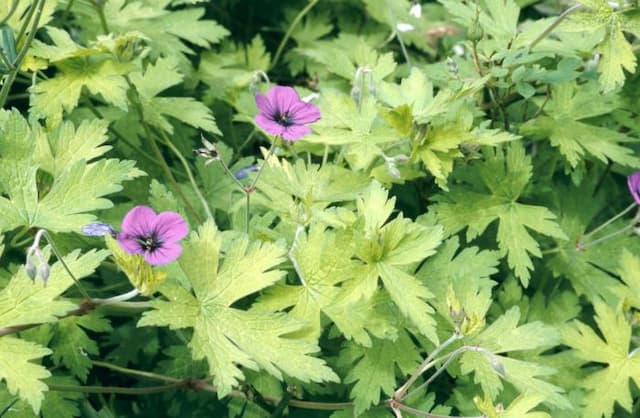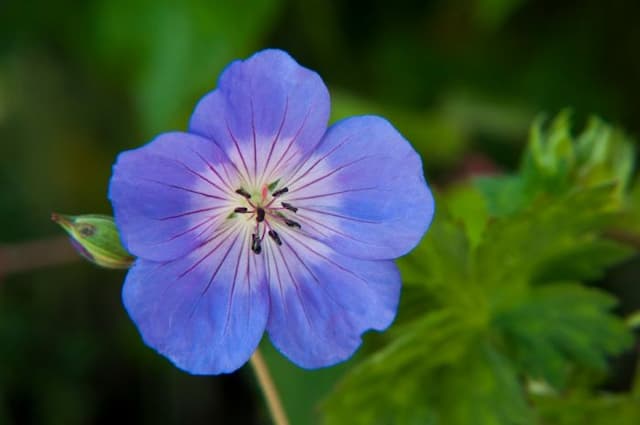Scented Geranium Pelargonium 'Hindoo' (R × U)

ABOUT
Pelargonium 'Hindoo' is a visually striking plant characterized by its bright and colorful foliage. The leaves are uniquely shaped, often resembling a zonal pattern with shades of green that can be edged or patterned with contrasting colors. The plant commonly showcases an abundant display of flowers, which are grouped in umbel-like clusters. These blossoms may come in a variety of hues including shades of pink, red, purple, or white, often marked with distinctive veining or eye-catching blotches. The petals can be smooth, ruffled, or even have a crinkly texture, adding to the ornamental appeal of the plant. The stems are sturdy and fleshy, commonly coated with fine hairs, and the entire plant often emits a pleasant, distinctive fragrance typical of many geraniums. Overall, Pelargonium 'Hindoo' is a popular choice for gardeners seeking to add vibrant colors and a touch of exotic flair to their floral arrangements or container gardens.
About this plant
 Names
NamesFamily
Geraniaceae.
Synonyms
No common names available.
Common names
Pelargonium 'Hindoo' (R × U)
 Toxicity
ToxicityTo humans
The plant commonly known as Geranium, specifically the Pelargonium 'Hindoo', is generally considered non-toxic to humans. However, ingestion can potentially cause minor symptoms such as nausea, vomiting, and diarrhea. In sensitive individuals, contact with the sap may cause skin irritation. If any parts of the plant are ingested, it is advisable to monitor for these symptoms and consult a medical professional if they arise or if there is significant discomfort.
To pets
Geraniums, including the Pelargonium 'Hindoo', can be toxic to pets if ingested. Symptoms of poisoning in pets may include vomiting, anorexia, depression, and dermatitis. In some cases, ingestion can lead to more serious outcomes. Pet owners should prevent their animals from ingesting parts of the plant and seek veterinary care if their pet exhibits any of these symptoms following possible ingestion.
 Characteristics
CharacteristicsLife cycle
Perennials
Foliage type
Evergreen
Color of leaves
Varies
Flower color
Mixed
Height
1-2 feet (30-60 cm)
Spread
1-2 feet (30-60 cm)
Plant type
Herb
Hardiness zones
10
Native area
South Africa
Benefits
 General Benefits
General Benefits- Decorative Appeal: Pelargonium 'Hindoo' adds color and texture to gardens and landscapes with its vibrant flowers and attractive foliage.
- Habitat Enrichment: Provides shelter and sometimes food for beneficial insects such as butterflies and bees.
- Aromatic Foliage: The leaves can be fragrant, delighting the senses when touched or brushed against.
- Low Maintenance: Generally requires less care compared to many other garden plants, making it suitable for different levels of gardeners.
- Drought Resistance: Once established, Pelargonium 'Hindoo' can tolerate periods of drought, making it ideal for xeriscaping or water-wise gardens.
- Container Gardening: Well-suited for pots and containers, providing flexibility in placement and easy incorporation into patios and balconies.
- Seasonal Interest: With a prolonged blooming period, it offers visual interest throughout the growing season.
- Versatility: Can be used in varied garden designs including borders, rockeries, and as a bedding plant.
 Medical Properties
Medical PropertiesThis plant is not used for medical purposes.
 Air-purifying Qualities
Air-purifying QualitiesThis plant is not specifically known for air purifying qualities.
 Other Uses
Other Uses- Culinary garnish: Petals of the geranium can be used to add a splash of color to salads or desserts, though it's essential to ensure they haven't been treated with pesticides.
- Artistic dye: The vibrant flowers can be used to create natural dyes for fabrics or paper, producing a range of pinkish hues.
- Aromatherapy: The scented leaves of the geranium can be incorporated into potpourris or sachets to provide a pleasant fragrance in drawers and closets.
- Mood enhancer: The essential oil from geranium leaves can be used in diffusers to create a calming atmosphere in the home or workplace.
- Insect deterrent: Growing geraniums around outdoor seating areas can help repel mosquitoes and other insects, making for a more pleasant environment.
- Companion planting: Geraniums can be planted alongside vegetables in gardens to help deter pests and enhance the overall health of the garden.
- Feline repellant: Some cats dislike the scent of geraniums, and planting them in certain areas can keep cats from digging or defecating in those spots.
- Cosmetic uses: Geranium oil, derived from the plant, is sometimes used in homemade skincare products for its fragrance and reputed astringent properties.
- Floral arrangements: Geranium flowers and foliage can be used in fresh floral arrangements to add variety and extend the life of the display.
- Symbolic gift: Different colors of geranium flowers can symbolize different emotions or messages, making them thoughtful gifts for special occasions.
Interesting Facts
 Feng Shui
Feng ShuiThe Geranium is not used in Feng Shui practice.
 Zodiac Sign Compitability
Zodiac Sign CompitabilityThe Geranium is not used in astrology practice.
 Plant Symbolism
Plant Symbolism- Hope: Geraniums are often associated with hope because they are hardy plants that can thrive in various conditions, reflecting the resilience required to maintain hope in challenging times.
- Friendship: As a gift, a geranium plant may signify a deepening friendship or a desire to foster a closer relationship, as they are seen as friendly, approachable plants.
- Comfort: The familiar scent and presence of geraniums can provide comfort, as they are often used in oils and aromatherapy for their soothing properties.
- Health: In some traditions, geraniums symbolize good health, as several species have been used in folk medicine to treat a variety of ailments.
- Fertility: Their lush, full-bodied leaves and frequent blossoming can symbolize fertility and abundance, making them fitting for occasions that celebrate new beginnings and growth.
- Positive energy: Geraniums are often believed to foster positive energy and vibes in a home by repelling negative energies and promoting a harmonious atmosphere.
 Water
WaterFor Pelargonium 'Hindoo', commonly known as Regal Geranium, it's important to water when the top inch of soil feels dry, which typically means watering every 7 to 10 days. The exact frequency depends on environmental conditions like temperature and humidity. Use room temperature water, and soak the soil thoroughly until water runs out of the drainage holes; this might equate to around 16-24 ounces for a pot with a 6-8 inch diameter every watering session. During the winter months, reduce watering as the plant enters dormancy. Avoid getting water on the leaves to prevent fungal infections. Do not let the plant sit in water, as this can cause root rot.
 Light
LightRegal Geraniums thrive in bright, indirect light and can tolerate direct morning light, but harsh afternoon sunlight may scorch their leaves. The ideal spot is near an east-facing window where the plant can receive gentle morning sunlight and bright indirect light for the rest of the day. If natural light is insufficient, consider using a grow light to supplement.
 Temperature
TemperatureRegal Geraniums prefer a temperate range between 65 to 75 degrees Fahrenheit. They can tolerate a temporary dip as low as 55 degrees at night but should not be exposed to temperatures below 50 degrees, as this can damage the plant. During the day, try to avoid overheating the plant with temperatures exceeding 80 degrees, as this can cause stress.
 Pruning
PruningRegal Geraniums benefit from regular pruning to remove dead or yellowing leaves and spent blooms, which helps prevent disease and encourages fuller growth. Perform more extensive pruning in the early spring to shape the plant and promote new growth. Pruning can be done every few weeks during the growing season to keep the plant tidy. The best time for major pruning is early spring before new growth begins.
 Cleaning
CleaningAs needed
 Soil
SoilGeraniums such as 'Hindoo' prefer a soil mix that is well-draining with equal parts peat, perlite, and potting soil. Aim for a slightly acidic to neutral pH of 6.0 to 7.0 for optimal growth.
 Repotting
RepottingGeraniums like 'Hindoo' should generally be repotted every 1 to 2 years, or when the plant has outgrown its current pot and roots are visibly filling the container.
 Humidity & Misting
Humidity & MistingGeraniums, including 'Hindoo', thrive best in average to slightly above average humidity levels, ideally between 40% to 60%.
 Suitable locations
Suitable locationsIndoor
Place in bright light, avoid overwatering, and ensure good airflow.
Outdoor
Choose a sunny spot, protect from frost, water moderately.
Hardiness zone
10-11 USDA
 Life cycle
Life cycleThe Pelargonium 'Hindoo', commonly known as Geranium, begins its life as a seed, which germinates in warm, moist soil within a few days to weeks depending on conditions. Upon germination, the seed develops into a seedling with true leaves that photosynthesize to fuel growth. As the plant matures, it grows into a bushy, herbaceous perennial with thick, succulent stems and brightly colored flowers that attract pollinators, entering its vegetative stage. The reproductive phase follows as flowers are pollinated and seed formation occurs, allowing for the dispersal and propagation of the geranium. Once the plant has reproduced, it may enter a period of dormancy, especially in cooler climates, where it can survive with minimal growth until favorable conditions return. Over time, the geranium may die back, completing its life cycle, but it can live and bloom for several years with proper care.
 Propogation
PropogationPropogation time
Spring-Early Summer
For the Pelargonium 'Hindoo', commonly known as Geranium, the most popular method of propagation is through stem cuttings. This is often done in spring or early summer when the plant's growth is most vigorous. To propagate, select a healthy stem and cut a 4 to 6-inch (approximately 10 to 15 cm) length just below a node using a clean, sharp tool. Remove the lower leaves to leave two to four leaves on the cutting, and let the cut end callous over for a few hours to reduce the risk of rot. The cutting can then be dipped in rooting hormone if desired and planted in a moist potting mix. Providing consistent warmth and humidity, such as with a plastic cover, can improve the chances of successful rooting. After a few weeks, when the cutting has established roots, it can be potted up into its own container.









